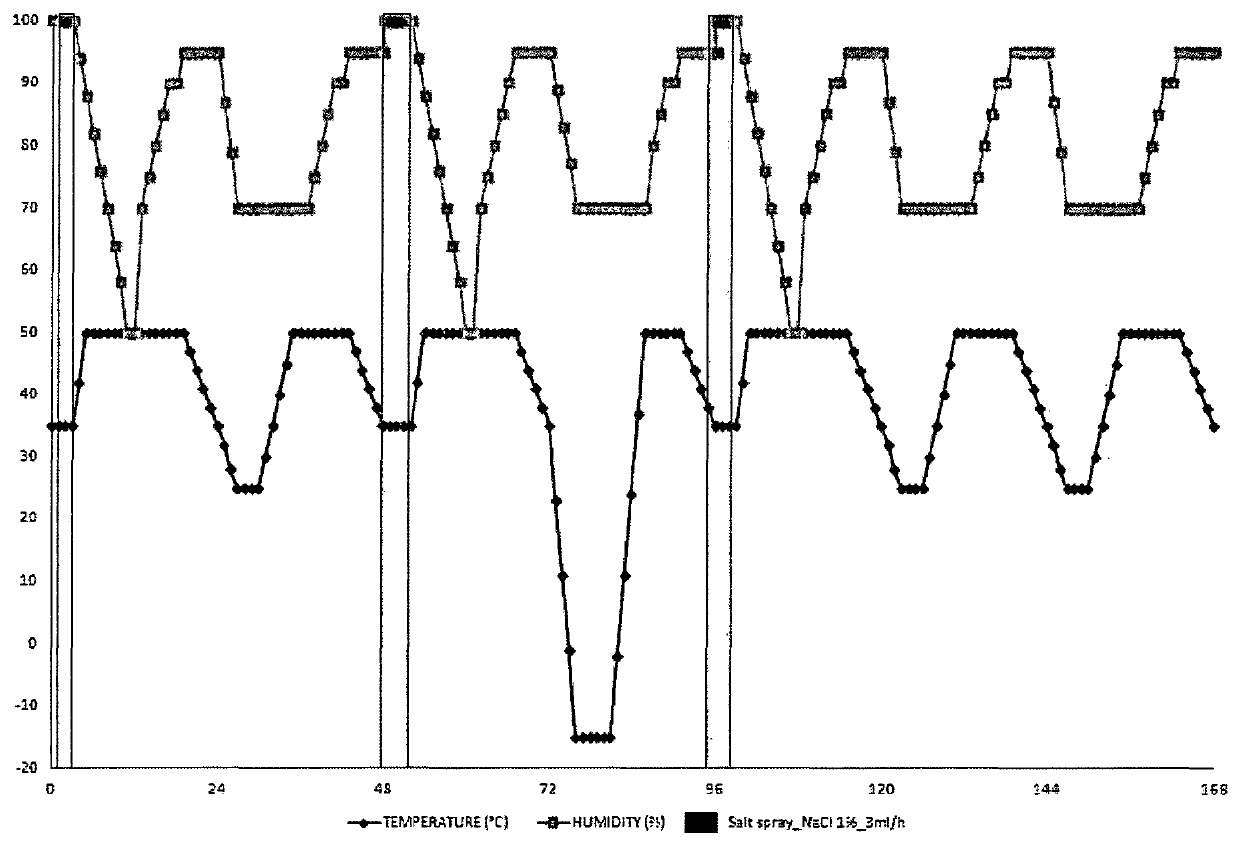Method for the manufacture of a phosphatable part starting from a steel sheet coated with a metallic coating based on aluminum
a technology of phosphate crystals and steel sheets, applied in the direction of superimposed coating process, heat treatment apparatus, furnaces, etc., can solve the problems of loss of productivity, increase of productivity costs, red rust areas, etc., and achieve high coverage rate of phosphate crystals, good paint adhesion, and easy implementation
- Summary
- Abstract
- Description
- Claims
- Application Information
AI Technical Summary
Benefits of technology
Problems solved by technology
Method used
Image
Examples
example 1
Phosphating Test
[0067]Phosphatability test is used to determine the adhesion of phosphate crystals on hardened parts by assessing the coverage rate on the part surface.
[0068]Trials 1 to 10 were prepared and subjected to the phosphating test.
[0069]To this end, coated trials were cut in order to obtain a blank. Blanks were then heated at a temperature of 900° C. during a dwell time varying between 5 and 10 minutes. Blanks were transferred into a press tool and hot-stamped in order to obtain a part. Finally, the part was cooled to obtain a hardening by martensitic transformation.
[0070]A degreasing was then realized. It was followed by a phosphating step realized by dipping into a bath comprising a solution of Gardobond® 24 TA, Gardobond® Add H7141, Gardobond® H7102, Gardobond® Add H7257, Gardobond® Add H7101, Gardobond® Add H7155 during 3 minutes at 50° C. Parts were then wiped with water and dried with hot air. The parts surface were observed by SEM. Results are shown in the following...
example 2
Paint Adhesion Test
[0072]This test is used to determine the paint adhesion of the hardened parts.
[0073]An e-coating layer of 20 μm is deposited on Trials 1 to 5 and 7 to 10 prepared in Example 1. To this end, all trials were dipped into a bath comprising an aqueous solution comprising Pigment Paste® W9712-N6 and Resin Blend® W7911-N6 of PPG Industries during 180 seconds at 30° C. A 200V current was applied. Then, the panel was wiped and cured in the oven at 180° C. during 35 minutes.
[0074]Then, painted parts are dipped into a sealed box comprising demineralized water during 10 days at a temperature of 50° C. After the dipping, a grid is realized with a cutter. The paint is ripped with a scotch.
[0075]The removed paint is assessed by naked eyes: 0 means excellent, in other words, there is a little or no paint removed and 5 means very bad, in other words, there are lots of paint removed. Results are shown in the following Table 2:
[0076]
Paint adhesion after a thermaltreatment at 900° C....
example 3
Delamination Test
[0078]This test is used to determine the corrosion after painting of the hardened parts.
[0079]An e-coating layer of 20 μm is deposited on Trials 1 to 5, 8 and 10 prepared at Example 1. To this end, all trials were dipped into a bath comprising an aqueous solution comprising Pigment Paste® W9712-N6 and Resin Blend® W7911-N6 of PPG Industries during 180 seconds at 30° C. A 200V current was applied. Then, the panel was wiped and cured in the oven at 180° C. during 35 minutes.
[0080]Then, scratches were realized on the e-coating layer with a cutter.
[0081]Finally, a test, consisting in submitting panels to corrosion cycles according to the norm VDA 233-102, was realized. Trials were put in a chamber wherein an aqueous solution of sodium chloride of 1% by weight was vaporized on trials with a rate of flow of 3 mL·h−1. The temperature varied from 50 to −15° C. and the humidity rate varied from 50 to 100%. FIG. 1 illustrates one cycle corresponding to 168 hours, i.e. one wee...
PUM
| Property | Measurement | Unit |
|---|---|---|
| temperature | aaaaa | aaaaa |
| temperature | aaaaa | aaaaa |
| thickness | aaaaa | aaaaa |
Abstract
Description
Claims
Application Information
 Login to View More
Login to View More - R&D
- Intellectual Property
- Life Sciences
- Materials
- Tech Scout
- Unparalleled Data Quality
- Higher Quality Content
- 60% Fewer Hallucinations
Browse by: Latest US Patents, China's latest patents, Technical Efficacy Thesaurus, Application Domain, Technology Topic, Popular Technical Reports.
© 2025 PatSnap. All rights reserved.Legal|Privacy policy|Modern Slavery Act Transparency Statement|Sitemap|About US| Contact US: help@patsnap.com

